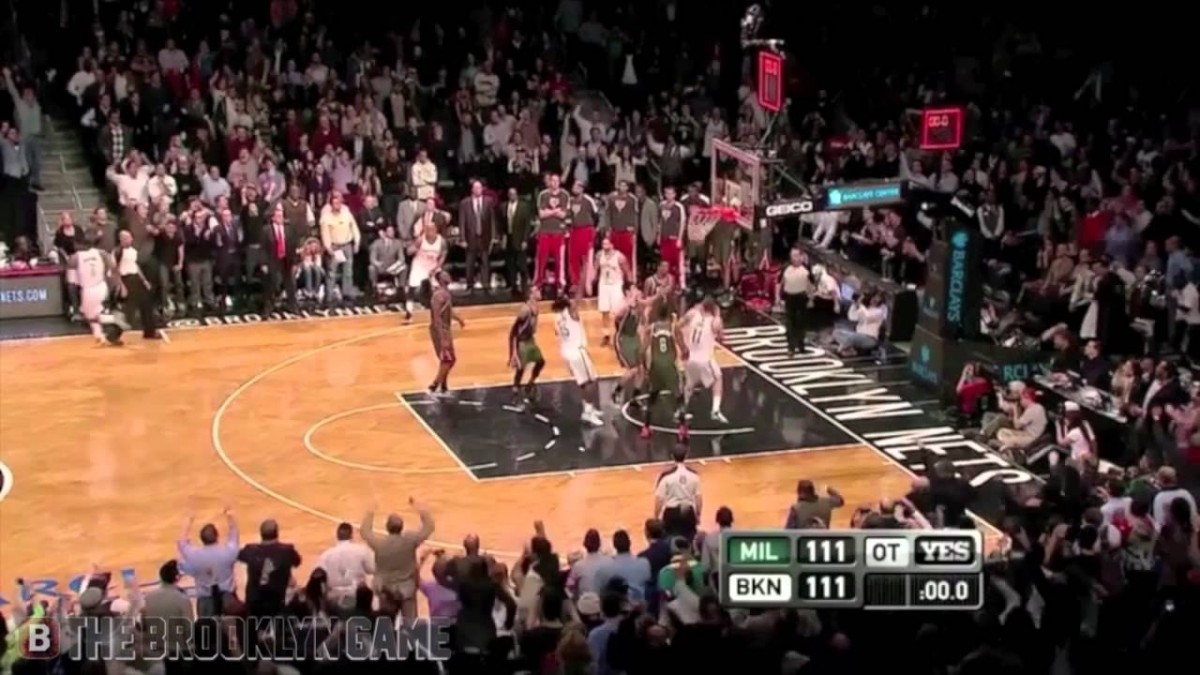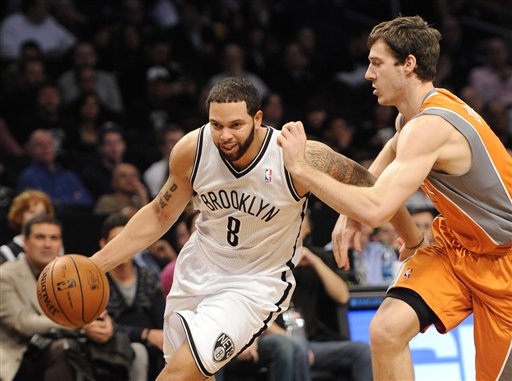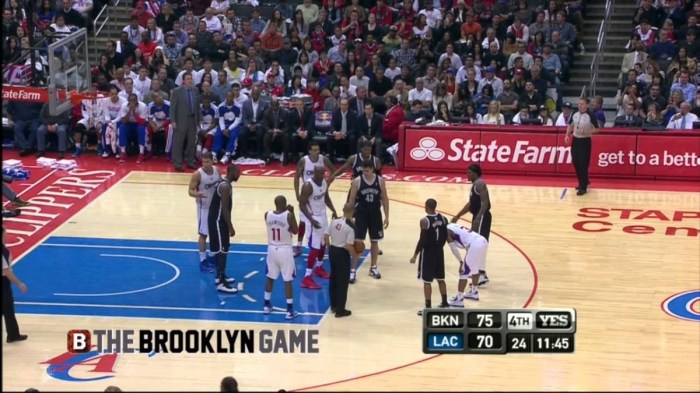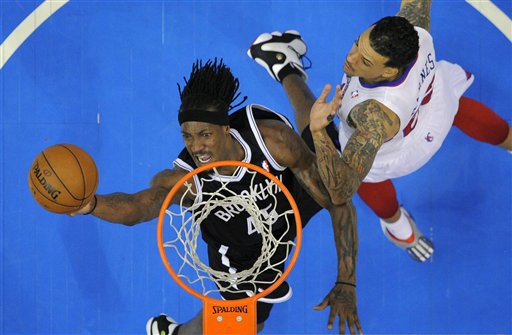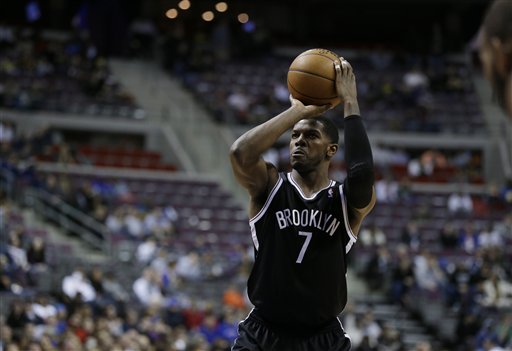
It’s the end of Brooklyn Nets training camp, and for the fifth straight day, Joe Johnson is the last guard shooting. He’s in the midst of a shooting drill with fellow guard Tyshawn Taylor, and Johnson’s consistent shooting form looks even more robotic next to the NBA sophomore.
Each time, Johnson jumps just a few inches off the ground, with the same catch, rise, form, flick. It’s clockwork, as his muscles click into place each time in a way that only thousands of hours of training can do — hours that Taylor is processing as we speak.
Johnson, of course, wins the shooting drill. He almost always does. In practice, he rarely misses, even after ninety minutes of NBA-level training and conditioning. He can’t help it. When you practice a skill as long as Joe Johnson has practiced shooting, when you’re as even-keeled as Johnson is, it’s hard to do anything different.
—
Joe Johnson got a new tattoo this summer.
“It’s almost like my skin peeling open,” Johnson says of the ink, which flows down the inside of his right forearm. “My skin peeled back, and inside, I’m like a machine.”
It’s true — instead of tendons and bone, the tattoo scrapes his body to reveal gears and pipes, the guts of an imperturbable contraption.“Produced in Little Rock” is imprinted in the middle, a reminder of his origins.
He is a machine: fine-tuned, cool and collected, instinctually programmed. But it wasn’t always that way.
Malcolm Gladwell says that much of what we call talent is the desire to practice. Basketball players — at least, the best of them — spend thousands upon thousands of hours honing their craft, sculpting their bodies and minds to maintain and improve precise, highly specialized skills. At some point, their fine-tuning turns into automation: every shot rolls off the fingertips the same way, every v-cut slashes at the correct angle, every off-hand moves to just the right spot to catch a between-the-legs dribble.
Except when it comes to the end of the game, when wins hang in the balance. Those highly specialized skills are imperative in these situations, but the players who so often resemble robots in practice wildly malfunction, shooting disparate sparks instead of their usual fire. Minds turn to mush instead of mainframes. With 30 seconds left and a game’s score within one possession, the NBA as a whole shot 33.6% from the field last season, a significant drop from the league’s normal field goal percentage of 45.3%.
You already know where this is going. Only two players shot at least nine field goal attempts and finished above 50% from the field — Los Angeles Clippers guard Chris Paul (6-10, 60%), and Brooklyn’s Joe Johnson (8-9, 88.9%).
Johnson only missed his first crunch-time attempt of the year — a floater with 24 seconds left against the Detroit Pistons on December 14th — and he made three more shots in crunch time in that game alone, including the game-winning buzzer-beater. Johnson took four game-winning shot attempts last season, and he made all four.
When it came to the last shot of a game last season, Joe Johnson was in a league of his own. And it wasn’t even close.
—
Johnson’s crunch-time decision-making isn’t predetermined, but he knows his bag of tricks and calls on whatever program he needs to get off the best look in the time alloted. If he sees the double-team, he’ll make the pass, but if he’s got one man and enough time to get off two moves, he knows his strengths. “It’s reading your defender,” Johnson says, knowing which way he’s leaning and forcing him to over-anticipate Johnson’s moves.
Johnson’s isolations aren’t the best play on the floor, but they’re a trade-off: since he so rarely turns the ball over, he’s able to get a shot off in a situation when the team might not otherwise be able to.
Year in and year out, the isolation ranks as the least efficient play in basketball, because they rarely end in open shots. Players who are one-on-one fanatics can so easily be thrown off with help defense. It’s a lot harder to score when three bodies are checking you than one. With so many offensive weapons on this Nets team, Johnson sees more opportunities for efficient one-on-one opportunities, not less.
That means in crunch time, when the floor’s spaced with shooters, he has all the space he wants to break down an inferior defender.
Johnson relishes in the opportunity to break down a defender, but doesn’t use it as a crutch. If the situation isn’t one-on-one, they’ll look for the open man. But Johnson doesn’t see the double-team — something he’s struggled against the past two seasons — happening as much this year. “I don’t really think you can double team, honestly, because we’ve got so many guys who are threats, can score, can make plays.”
And if the opponent doesn’t bring the extra defender in time, Johnson will make them pay.
Success breeds further experimentation. Johnson didn’t enter last season expecting to be the team’s crunch time facilitator, but it just worked out that way. “My first game-winner was the Detroit game, but it started there because I was in a rhythm that game. I was playing pretty good. So going down the stretch (then-coach Avery Johnson) went with me. That could’ve been anybody. If D-Will was rolling, he probably would’ve went with D. I was rolling that game, and he went with me, and I made like 2 or 3 clutch baskets in that game. So he just kept rolling.”
In that game, 9 of Johnson’s 14 two-point attempts before the final shot came from within ten feet of the basket. Johnson wanted to get there again, but against a long defender in Tayshaun Prince, he adjusted on the fly to get the separation he needed.
—
Joe Johnson may have always had the reputation as the shooter, but turning into the scorer was an evolutionary process. After signing a five-year deal worth approximately $70 million to be the first option in Atlanta, the role came naturally, but the crunch time scoring didn’t. In Johnson’s first three seasons with the Hawks, he shot an abysmal 15-58 (25.9%) in crunch time. He improved that number slightly in his next three seasons, shooting 11-31 (35.5%), before turning into the machine he’s been in the past two seasons.
Since Johnson became a first option with Atlanta in 2005, only Los Angeles Lakers guard Kobe Bryant has attempted more crunch-time field goals (135) than Johnson’s 111, and Bryant’s notorious for hijacking the offense, rather than facilitating it.
Crunch-time production is fluky by nature, because you’re talking about a sample set small enough to come with wacky fluctuations. Players can’t necessarily improve upon what they already are, but some players are better than others at processing those moments. After years of sustained, meditative practice, both in body and mind, he locks in, machine more than man, and lets his training take over. “Instinct,” Johnson says often of these shots. “All instinct.”
It’s why Johnson can appear to elevate their game. Even if hitting eight shots in nine attempts is unsustainable, players like Johnson and Chris Paul can sustain decent production in high-pressure moments year in and year out while most players can’t. It’s why Johnson’s fluky season is 8-9, when others might be 5-12.
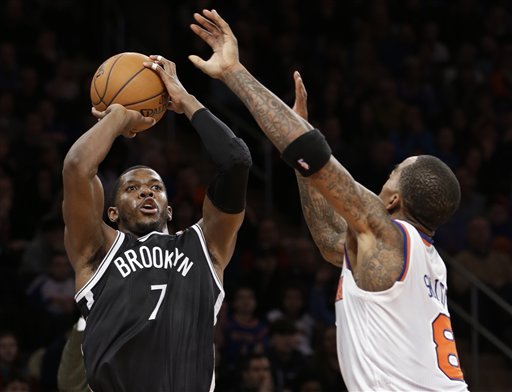
And any complications with Pierce? They’ve been playing together all week on Brooklyn’s “black” squad in scrimmages. Jason Terry, who’s sat out of contact portions of practice as he nurses his right knee, has a front-row seat to the pairing.
“He and Paul Pierce have looked real good and comfortable together, like they’ve been playing together for three or four years now,” Terry said of the two. “That’s a position that you think would be kind of uneasy, but it’s really been a smooth transition for those two.”
The Nets have a bevy of offensive weapons this season. Along with Johnson, the team brought back Deron Williams and Brook Lopez, two of the more explosive offensive threats in the league. Williams in particular has taken 91 crunch-time attempts since 2005, They added Pierce and Terry, two players that relish in high-pressure moments, and Kevin Garnett, a mid-range weapon as effective as anyone in the NBA. (Johnson, by the way, learned about that trade when his cousin saw it on HoopsHype. “He said, ‘Man, y’all supposed to be getting KG, and Paul, and Terry.’ I was like, ‘Nah, ain’t no way.'”)
With those options, Johnson doesn’t think he’ll touch the ball so much at the end of the game. “In these situations, if people are going off statistics, then they probably won’t let me or Paul catch, to be honest. … I think it’s gonna come down to who’s rolling or what we need.”
And if he does? Joe Cool, Produced In Little Rock, is ready. “I love those moments,” Johnson says, showing rare emotion about his on-court product.
“Like I say, me being 6’7″, 6’8″, one-on-one at the end of the game, I don’t care who you are, man, it’s gonna be hard to stop me.”

